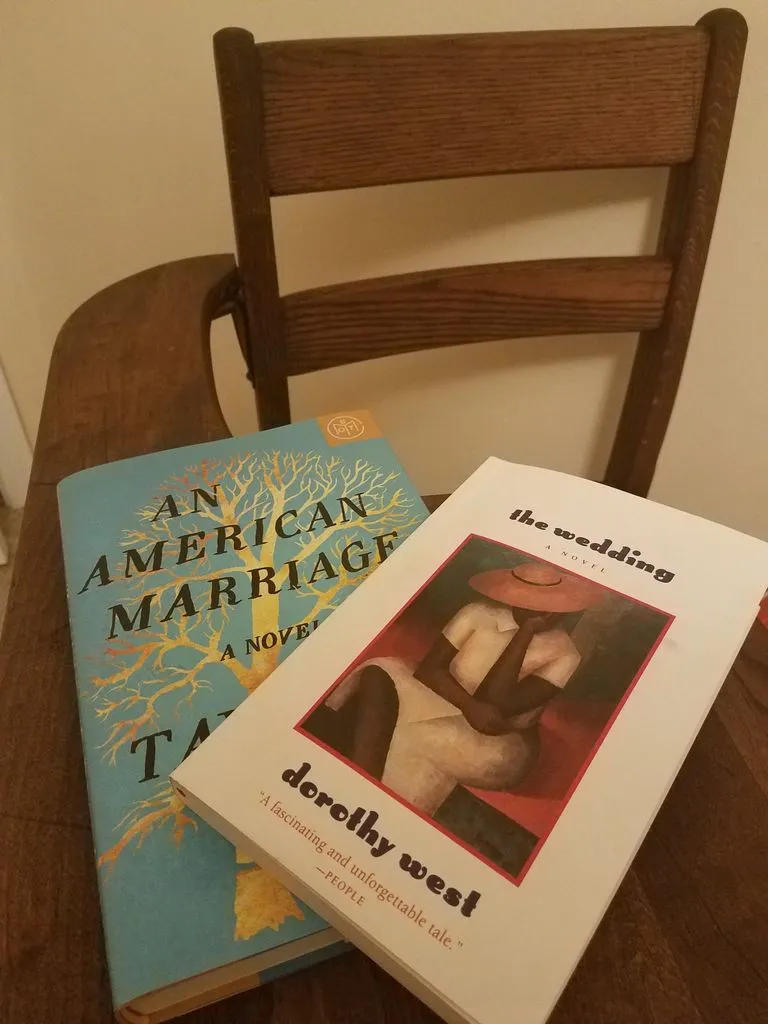
The Wedding and An American Marriage
This content contains affiliate links. When you buy through these links, we may earn an affiliate commission.
This month, my Book of the Month selection was the recently released and highly praised An American Marriage by Tayari Jones. Like the thousands of Instagram users that flaunted their love of the novel, I, too, couldn’t wait to delve into the pages, especially since I loved Jones’s Silver Sparrow. I was not disappointed. Instantly, the smooth cadence of the characters captivated me and the impending doom the author so brilliantly cascaded upon the reader had me hooked. Undoubtedly, there were some predictable moments—which is part of the realistic and gritty appeal the novel offers: the dread the reader feels as the words of the novel sink into them mirrors the impact of current headlines. The plot thickened in myriad ways as the characters not only faced the normal nuances of marriage, but were bombarded with forced distance—both physically and communicative—under the weight of racism and injustice.
 The tangled roots that intertwined the characters to their pain instantly reminded me of Dorothy West’s The Wedding. Though the novels focus on different stages of commitment in different decades, they both allow for a meditative reckoning of the power of love in relationships and the wounds that only society’s racist constructs can inflict.
Both novels focus on the love that either is, should, or could be the center of a marriage. But, what sets An American Marriage and The Wedding apart is the irrefutable struggle the characters face for the chance—the choice— to either thrive or crumble under the potential of love. Jones and West’s words depict worlds where racism, colorism, and classism leave little room for the characters to exist, much less love beneath the pressure of the pages. But endure and thrive they do. By the end of the both novels, characters are able to form new realities and new loves; these lives, however, do little to dampen the heartache the pages before embedded into the hearts of readers.
The tangled roots that intertwined the characters to their pain instantly reminded me of Dorothy West’s The Wedding. Though the novels focus on different stages of commitment in different decades, they both allow for a meditative reckoning of the power of love in relationships and the wounds that only society’s racist constructs can inflict.
Both novels focus on the love that either is, should, or could be the center of a marriage. But, what sets An American Marriage and The Wedding apart is the irrefutable struggle the characters face for the chance—the choice— to either thrive or crumble under the potential of love. Jones and West’s words depict worlds where racism, colorism, and classism leave little room for the characters to exist, much less love beneath the pressure of the pages. But endure and thrive they do. By the end of the both novels, characters are able to form new realities and new loves; these lives, however, do little to dampen the heartache the pages before embedded into the hearts of readers.
 The tangled roots that intertwined the characters to their pain instantly reminded me of Dorothy West’s The Wedding. Though the novels focus on different stages of commitment in different decades, they both allow for a meditative reckoning of the power of love in relationships and the wounds that only society’s racist constructs can inflict.
Both novels focus on the love that either is, should, or could be the center of a marriage. But, what sets An American Marriage and The Wedding apart is the irrefutable struggle the characters face for the chance—the choice— to either thrive or crumble under the potential of love. Jones and West’s words depict worlds where racism, colorism, and classism leave little room for the characters to exist, much less love beneath the pressure of the pages. But endure and thrive they do. By the end of the both novels, characters are able to form new realities and new loves; these lives, however, do little to dampen the heartache the pages before embedded into the hearts of readers.
The tangled roots that intertwined the characters to their pain instantly reminded me of Dorothy West’s The Wedding. Though the novels focus on different stages of commitment in different decades, they both allow for a meditative reckoning of the power of love in relationships and the wounds that only society’s racist constructs can inflict.
Both novels focus on the love that either is, should, or could be the center of a marriage. But, what sets An American Marriage and The Wedding apart is the irrefutable struggle the characters face for the chance—the choice— to either thrive or crumble under the potential of love. Jones and West’s words depict worlds where racism, colorism, and classism leave little room for the characters to exist, much less love beneath the pressure of the pages. But endure and thrive they do. By the end of the both novels, characters are able to form new realities and new loves; these lives, however, do little to dampen the heartache the pages before embedded into the hearts of readers.












